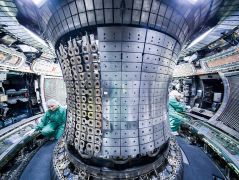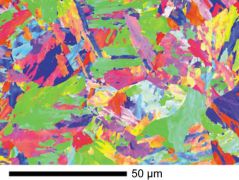MLZ is a cooperation between:
 > Technische Universität München
> Technische Universität München > Helmholtz-Zentrum Hereon
> Helmholtz-Zentrum Hereon
 > Forschungszentrum Jülich
> Forschungszentrum Jülich
MLZ is a member of:
 > LENS
> LENS > ERF-AISBL
> ERF-AISBL
MLZ on social media:

MLZ (eng)
Lichtenbergstr.1
85748 Garching
15.12.2023
Neutrons drive fusion research forward
Fusion research reactors require heat-resistant wall materials. Researchers have investigated a promising candidate with neutrons at the MLZ.

This is not a picture by an Impressionist painter. It shows the orientation of the crystal structure in steel, as measured by the researchers. © FRM II / TUM
The walls of a fusion reactor require materials that can withstand extreme conditions. However, when iron is exposed to high-energy radiation, small pores form. The researchers solved this problem by adding some chromium and traces of other elements. However, these precipitate at high temperatures or under neutron bombardment and impair the heat resistance of the alloy, among other things.
Steel samples examined with neutrons
Dr. Andreas Ulbricht and Dr. Frank Bergner from the Helmholtz-Zentrum Dresden Rossendorf treated steel samples with high-energy neutrons to better understand how these precipitations occur. They then examined the samples with Dr. André Heinemann from the Helmholtz-Zentrum Hereon at the SANS-1 instrument of the Heinz Maier-Leibnitz Zentrum.

Dr. André Heinemann prepares a sample at the SANS-1 instrument of the MLZ. © Bernhard Ludewig, FRM II / TUM
What influence do high temperatures have?
SANS-1 emits neutrons with low energy, which are scattered by the precipitations and thus allow conclusions to be drawn about the type and size of the deposits. This enabled the researchers to better understand the influence of higher chromium concentrations and different temperatures on the material’s properties.
The results will enable researchers to develop better materials for safe operation in the future.
Original publication:
Andreas Ulbricht, André Heinemann, and Frank Bergner
Small-angle neutron scattering applied to low-dose neutron-irradiated Fe–Cr alloys and ferritic martensitic steel Eurofer97
J. Appl. Cryst. (2022). 55, 702-712
10.1107/S1600576722004800
More information:
The project received financial support from the European Commission under the Seventh Framework Program (FP7) project MatISSE (grant agreement No. 604862) and contributes to the Joint Programme on Nuclear Materials (JPNM) of the European Energy Research Alliance (EERA).
In addition to the MLZ, researchers from the Helmholtz-Zentrum Dresden Rossendorf were also involved.
Related News
MLZ is a cooperation between:
 > Technische Universität München
> Technische Universität München > Helmholtz-Zentrum Hereon
> Helmholtz-Zentrum Hereon
 > Forschungszentrum Jülich
> Forschungszentrum Jülich
MLZ is a member of:
 > LENS
> LENS > ERF-AISBL
> ERF-AISBL
MLZ on social media:




